Journal Description
Biosensors
Biosensors
is an international, peer-reviewed, open access journal on the technology and science of biosensors published monthly online by MDPI.
- Open Access— free for readers, with article processing charges (APC) paid by authors or their institutions.
- High Visibility: indexed within Scopus, SCIE (Web of Science), PubMed, MEDLINE, PMC, Embase, CAPlus / SciFinder, Inspec, and other databases.
- Journal Rank: JCR - Q1 (Instruments and Instrumentation) / CiteScore - Q1 (Instrumentation)
- Rapid Publication: manuscripts are peer-reviewed and a first decision is provided to authors approximately 21.8 days after submission; acceptance to publication is undertaken in 2.8 days (median values for papers published in this journal in the first half of 2025).
- Recognition of Reviewers: reviewers who provide timely, thorough peer-review reports receive vouchers entitling them to a discount on the APC of their next publication in any MDPI journal, in appreciation of the work done.
Impact Factor:
5.6 (2024);
5-Year Impact Factor:
5.7 (2024)
Latest Articles
Nanomaterials for Sensory Systems—A Review
Biosensors 2025, 15(11), 754; https://doi.org/10.3390/bios15110754 - 11 Nov 2025
Abstract
Nanotechnology offers powerful new tools to enhance food quality monitoring and safety assurance. In the food industry, nanoscale materials (e.g., metal, metal oxide, carbon, and polymeric nanomaterials) are being integrated into sensory systems to detect spoilage, contamination, and intentional food tampering with unprecedented
[...] Read more.
Nanotechnology offers powerful new tools to enhance food quality monitoring and safety assurance. In the food industry, nanoscale materials (e.g., metal, metal oxide, carbon, and polymeric nanomaterials) are being integrated into sensory systems to detect spoilage, contamination, and intentional food tampering with unprecedented sensitivity. Nanosensors can rapidly identify foodborne pathogens, toxins, and chemical changes that signal spoilage, overcoming the limitations of conventional assays that are often slow, costly, or require expert operation. These advances translate into improved food safety and extended shelf-life by allowing early intervention (for example, via antimicrobial nano-coatings) to prevent spoilage. This review provides a comprehensive overview of the types of nanomaterials used in food sensory applications and their mechanisms of action. We examine current applications in detecting food spoilage indicators and adulterants, as well as recent innovations in smart packaging and continuous freshness monitoring. The advantages of nanomaterials—including heightened analytical sensitivity, specificity, and the ability to combine sensing with active preservative functions—are highlighted alongside important toxicological and regulatory considerations. Overall, nanomaterials are driving the development of smarter food packaging and sensor systems that promise safer foods, reduced waste, and empowered consumers. However, realizing this potential will require addressing safety concerns and establishing clear regulations to ensure responsible deployment of nano-enabled food sensing technologies. Representative figures of merit include Au/AgNP melamine tests with LOD 0.04–0.07 mg L−1 and minute-scale readout, a smartphone Au@carbon-QD assay with LOD 3.6 nM, Fe3O4/DPV detection of Sudan I at 0.001 µM (linear 0.01–20 µM), and a reusable Au–Fe3O4 piezo-electrochemical immunosensor for aflatoxin B1 with LOD 0.07 ng mL−1 (≈15 × reuse), alongside freshness labels that track TVB-N/amine in near-real time and e-nose arrays distinguishing spoilage stages.
Full article
(This article belongs to the Section Environmental Biosensors and Biosensing)
►
Show Figures
Open AccessArticle
Deep Learning-Based Prediction of Individual Cell α-Dispersion Capacitance from Morphological Features
by
Tae Young Kang, Soojung Kim, Yoon-Hwae Hwang and Kyujung Kim
Biosensors 2025, 15(11), 753; https://doi.org/10.3390/bios15110753 - 10 Nov 2025
Abstract
The biophysical characteristics of cellular membranes, particularly their electrical properties in the
The biophysical characteristics of cellular membranes, particularly their electrical properties in the
(This article belongs to the Special Issue Advanced Cell-Analyzing Technologies and Their Biosensing Applications)
►▼
Show Figures

Figure 1
Open AccessFeature PaperReview
Progress in the Design and Application of Chemical and Biological Sensors Based on Atom Transfer Radical Polymerization
by
Ning Xia, Fengli Gao, Zhaojiang Yu, Shuaibing Yu and Xinyao Yi
Biosensors 2025, 15(11), 752; https://doi.org/10.3390/bios15110752 - 10 Nov 2025
Abstract
Atom transfer radical polymerization (ATRP) is a leading reversible deactivation radical polymerization method. It has become an emerging technology to synthesize well-defined, tailor-made polymers, promoting the development of advanced materials (e.g., bioconjugates and nanocomposites) with precisely designed and controlled macromolecular architectures. ATRP-produced polymers
[...] Read more.
Atom transfer radical polymerization (ATRP) is a leading reversible deactivation radical polymerization method. It has become an emerging technology to synthesize well-defined, tailor-made polymers, promoting the development of advanced materials (e.g., bioconjugates and nanocomposites) with precisely designed and controlled macromolecular architectures. ATRP-produced polymers or polymeric materials have been successfully applied in the fields of drug delivery, tissue engineering, sample separation, environmental monitoring, bioimaging, clinical diagnostics, etc. In this review, we systematically summarize the progress of ATRP-based chemical and biological sensors in different application fields, including ion sensing, small-molecule detection, bioimaging, and signal amplification for biosensors. Finally, we briefly outline the prospects and future directions of ATRP. This review is expected to provide a fundamental and timely understanding of ATRP-based sensors and guide the design of novel materials and methods for sensing applications.
Full article
(This article belongs to the Special Issue Advanced Materials for Electrochemical Sensors and Biosensors Development—2nd Edition)
►▼
Show Figures

Figure 1
Open AccessCommunication
DNA-Decorated PET Nanochannels for Sensitive Biosensing
by
Xianyan Gong, Hongquan Xu, Xigui Zhang and Dagui Wang
Biosensors 2025, 15(11), 751; https://doi.org/10.3390/bios15110751 - 10 Nov 2025
Abstract
Functionalized nanochannels are crucial for achieving excellent ion transport properties and enable versatile applications such as ion gating, biosensing, and energy conversion. Conical single nanochannels were fabricated in single-ion-track polyethylene terephthalate (PET) membranes using the ion-track-etching method. Leveraging the high programmability of deoxyribonucleic
[...] Read more.
Functionalized nanochannels are crucial for achieving excellent ion transport properties and enable versatile applications such as ion gating, biosensing, and energy conversion. Conical single nanochannels were fabricated in single-ion-track polyethylene terephthalate (PET) membranes using the ion-track-etching method. Leveraging the high programmability of deoxyribonucleic acid (DNA) strands, a series of DNA molecules were designed to functionalize the outer surface at the tip region (small opening) of the conical PET nanochannels. This approach enabled precise regulation of both spatial charge distribution and steric hindrance on the outer surface, enabling the investigation of ion transport properties under the dominance of outer surface charge effects across ions of different valences. In contrast to the low-valence K+, the high-valence cation Ru(NH3)63+ exhibited far greater enhancement in ionic current rectification (ICR) within PET films functionalized with DNA of varying charge densities. We used COMSOL simulations to corroborate that higher-valence ions exert more pronounced effects on ion transport in conical nanochannels with greater outer surface charge density. Furthermore, it was confirmed that the tip region plays a critical role in modulating the ion transport properties of conical nanochannels, thereby validating outer surface functionalization as a rational and efficient strategy.
Full article
(This article belongs to the Section Nano- and Micro-Technologies in Biosensors)
►▼
Show Figures

Figure 1
Open AccessArticle
Rapid On-Site Detection of Pseudomonas aeruginosa via ecfX-Targeted Loop-Mediated Isothermal Amplification
by
Xuliang He, Meimei Zeng, Wentao Bai, Ziyan Tang, Jianhua Ding and Zhu Chen
Biosensors 2025, 15(11), 750; https://doi.org/10.3390/bios15110750 - 7 Nov 2025
Abstract
Pseudomonas aeruginosa (PA) is a significant pathogen of clinical concern that is frequently associated with multidrug resistance, leading to respiratory tract, wound, and hospital-acquired infections. To enable rapid and accurate detection, we developed a fluorescence-based loop-mediated isothermal amplification (LAMP) method, targeting the PA-specific
[...] Read more.
Pseudomonas aeruginosa (PA) is a significant pathogen of clinical concern that is frequently associated with multidrug resistance, leading to respiratory tract, wound, and hospital-acquired infections. To enable rapid and accurate detection, we developed a fluorescence-based loop-mediated isothermal amplification (LAMP) method, targeting the PA-specific ecfX gene. Among ten primer sets designed, the optimal set (EC2) was identified, and reaction conditions were optimized (Bst polymerase 320 U/mL, Mg2+ 8 mM, dNTP 1.4 mM, inner/outer primer ratio 1:8, 64 °C, 20 min). The assay demonstrated a detection limit that was comparable to a real-time polymerase chain reaction and immunochromatographic assays, but with a markedly reduced turnaround time. No cross-reactivity was observed with non-PA pathogens, and reproducibility tests confirmed high stability. In addition, the reliability of the results was further verified using 60 standard bacterial strains, and the feasibility of the assay was validated with 2 real soil samples and 1 water sample. This LAMP method offers a simple, rapid, and sensitive tool for on-site detection of PA, with potential applications in clinical diagnostics and public health surveillance.
Full article
(This article belongs to the Special Issue Sensors for Detection of Virus and Bacteria)
►▼
Show Figures

Figure 1
Open AccessReview
Potential-Resolved Electrochemiluminescence and Its Application in Disease Biomarker Detection
by
Liangbiao Wang, Xiaojing Su, Rongrong Han, Dexin Du and Mingquan Guo
Biosensors 2025, 15(11), 749; https://doi.org/10.3390/bios15110749 - 7 Nov 2025
Abstract
Electrochemiluminescence (ECL) is a chemiluminescence phenomenon triggered by electrochemical reactions at the electrode surface, which has gradually become a high-sensitivity detection technology due to its low background, simple instrumentation, and high sensitivity. Therein, potential-resolved ECL refers to the generation of two or more
[...] Read more.
Electrochemiluminescence (ECL) is a chemiluminescence phenomenon triggered by electrochemical reactions at the electrode surface, which has gradually become a high-sensitivity detection technology due to its low background, simple instrumentation, and high sensitivity. Therein, potential-resolved ECL refers to the generation of two or more ECL signals with distinct potentials and wavelengths during an electrochemical process. This unique capability enables simultaneous multi-signal outputs, making potential-resolved ECL particularly promising for self-calibration and multiplexed detection strategies. In this review, we focus on two critical aspects: on the one hand, the advancement of traditional ECL luminophores and potential-resolved ECL systems was reviewed, which were classified, respectively, into three categories to be introduced in detail (inorganic, organic and nanomaterial-based ECL luminophores or potential-resolved ECL of metal–organic complexes, layer-by-layer-modified electrodes, and nanomaterials). On the other hand, we summarized ECL detection strategies based on potential-resolved ECL systems and the application of these protocols in disease biomarker detection, which results in two categories (self-calibration strategies and multi-target strategies) for discussion. In this work, we aim to inspire investigators to explore novel ECL luminophores and design detection strategies with high performance, which could provide strong support for precision medicine, personalized assessment, portable medical devices, and the digital transformation of healthcare.
Full article
(This article belongs to the Special Issue Progress in Electrochemiluminescence Biosensors)
►▼
Show Figures

Figure 1
Open AccessCorrection
Correction: Zhao et al. LAMP-Based 4-Channel Microfluidic Chip for POCT Detection of Influenza A H1N1, H3N2, and Influenza B Victoria Viruses. Biosensors 2025, 15, 506
by
Xue Zhao, Jiale Gao, Yijing Gu, Zheng Teng, Xi Zhang, Huanyu Wu, Xin Chen, Min Chen and Jilie Kong
Biosensors 2025, 15(11), 748; https://doi.org/10.3390/bios15110748 - 7 Nov 2025
Abstract
In the original publication [...]
Full article
(This article belongs to the Section Nano- and Micro-Technologies in Biosensors)
Open AccessArticle
Construction of an Immunosensor Based on the Affinity DNA Functional Ligands to the Fc Segment of IgG Antibody
by
Qianyu Yang, Zhiwei Liu, Xinrui Xu, Zihao Zhao, Ze Fan, Bin Du, Jianjie Xu, Jiwei Xu, Jiang Wang, Bing Liu, Xihui Mu and Zhaoyang Tong
Biosensors 2025, 15(11), 747; https://doi.org/10.3390/bios15110747 - 5 Nov 2025
Abstract
Over the past few decades, Fc fragment-conjugated proteins, such as Protein A, have been extensively utilized across a range of applications, including antibody purification, site-specific immobilization of antibodies, and the development of biosensing platforms. In this study, building upon our group prior research,
[...] Read more.
Over the past few decades, Fc fragment-conjugated proteins, such as Protein A, have been extensively utilized across a range of applications, including antibody purification, site-specific immobilization of antibodies, and the development of biosensing platforms. In this study, building upon our group prior research, we designed and screened an affinity DNA functional ligand (A-DNAFL) and experimentally validated its binding affinity (KD = 6.59 × 10−8) toward mouse IgG antibodies, whose binding performance was comparable to that of protein A. Systematic evaluations were performed to assess the binding efficiency under varying pH levels and ionic strength conditions. Optimal antibody immobilization was achieved in PBST-B buffer under physiological pH 7.2–7.4 and containing approximately 154 mM Na+ and 4 mM K+. Two competitive binding assays confirmed that the A-DNAFL binds to the Fc fragment of murine IgG antibody. Furthermore, molecular docking simulations were employed to investigate the interaction mode, revealing key residues involved in binding as well as the contributions of hydrogen bonding and hydrophobic interactions to complex stabilization. Leveraging these insights, A-DNAFL was utilized as a tool for oriented immobilization of antibodies on the sensing interface, enabling the construction of an immunosensor for ricin detection. Following optimization of immobilization parameters, the biosensor exhibited a detection limit of 30.5 ng/mL with the linear regression equation is lg(Response) = 0.329 lg(Cricin) − 2.027 (N = 9, R = 0.938, p < 0.001)—representing a 64-fold improvement compared to conventional protein A-based methods. The system demonstrated robust resistance to nonspecific interference. Sensing interface reusability was also evaluated, showing only 8.55% signal reduction after two regeneration cycles, indicating that glycine effectively elutes bound antibodies while preserving sensor activity. In summary, the A-DNAFL presented in this study represents a novel antibody-directed immobilization material that serves as a promising alternative to protein A. It offers several advantages, including high modifiability, low production cost, and a relatively small molecular weight. These features collectively contribute to its broad application potential in biosensing, antibody purification, and other areas of life science research.
Full article
(This article belongs to the Section Biosensors and Healthcare)
►▼
Show Figures
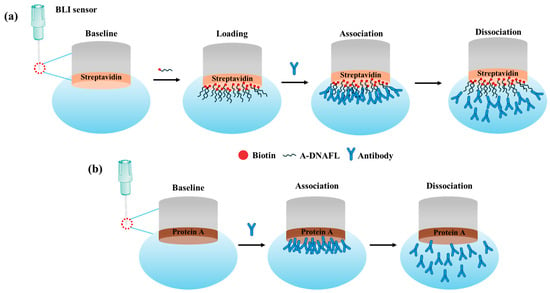
Figure 1
Open AccessEditorial
Electrochemical (Bio-) Sensors in Biological Applications—2nd Edition
by
Sergey Shleev, Cecilia Cristea and Nina Dimcheva
Biosensors 2025, 15(11), 746; https://doi.org/10.3390/bios15110746 - 5 Nov 2025
Abstract
The International Union of Pure and Applied Chemistry (IUPAC; https://iupac [...]
Full article
(This article belongs to the Special Issue Electrochemical (Bio-) Sensors in Biological Applications—2nd Edition)
Open AccessArticle
Real-Time Detection of Industrial Respirator Fit Using Embedded Breath Sensors and Machine Learning Algorithms
by
Pablo Aqueveque, Pedro Pinacho-Davidson, Emilio Ramos, Sergio Sobarzo, Francisco Pastene and Anibal S. Morales
Biosensors 2025, 15(11), 745; https://doi.org/10.3390/bios15110745 - 5 Nov 2025
Abstract
Maintaining an effective facial seal is critical for the performance of tight-fitting industrial respirators used in high-risk sectors such as mining, manufacturing, and construction. Traditional fit verification methods—Qualitative Fit Testing (QLFT) and Quantitative Fit Testing (QNFT)—are limited to periodic assessments and cannot detect
[...] Read more.
Maintaining an effective facial seal is critical for the performance of tight-fitting industrial respirators used in high-risk sectors such as mining, manufacturing, and construction. Traditional fit verification methods—Qualitative Fit Testing (QLFT) and Quantitative Fit Testing (QNFT)—are limited to periodic assessments and cannot detect fit degradation during active use. This study presents a real-time fit detection system based on embedded breath sensors and machine learning algorithms. A compact sensor module inside the respirator continuously measures pressure, temperature, and humidity, transmitting data via Bluetooth Low Energy (BLE) to a smartphone for on-device inference. This system functions as a multimodal biosensor: intra-mask pressure tracks flow-driven mechanical dynamics, while temperature and humidity capture the thermal–hygrometric signature of exhaled breath. Their cycle-synchronous patterns provide an indirect yet reliable readout of respirator–face sealing in real time. Data were collected from 20 healthy volunteers under fit and misfit conditions using OSHA-standardized procedures, generating over 10,000 labeled breathing cycles. Statistical features extracted from segmented signals were used to train Random Forest, Support Vector Machine (SVM), and XGBoost classifiers. Model development and validation were conducted using variable-size sliding windows depending on the person’s breathing cycles, k-fold cross-validation, and leave-one-subject-out (LOSO) evaluation. The best-performing models achieved F1 scores approaching or exceeding 95%. This approach enables continuous, non-invasive fit monitoring and real-time alerts during work shifts. Unlike conventional techniques, the system relies on internal physiological signals rather than external particle measurements, providing a scalable, cost-effective, and field-deployable solution to enhance occupational safety and regulatory compliance.
Full article
(This article belongs to the Special Issue Portable Bioelectronic Devices for Telemedicine, Healthcare and Sports Applications)
►▼
Show Figures
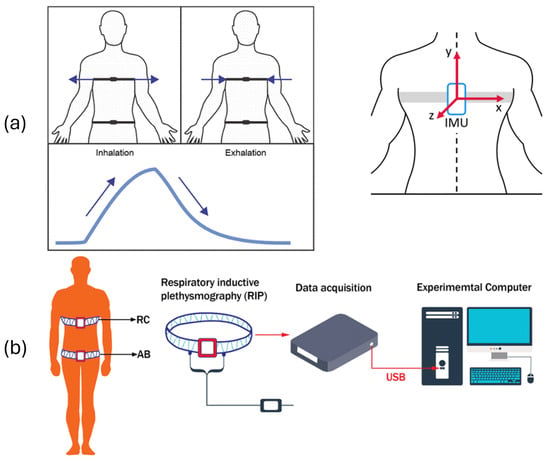
Figure 1
Open AccessArticle
Plant Bioelectrical Signals for Environmental and Emotional State Classification
by
Peter A. Gloor
Biosensors 2025, 15(11), 744; https://doi.org/10.3390/bios15110744 - 5 Nov 2025
Abstract
In this study, we present a pilot investigation using a single Purple Heart plant (Tradescantia pallida) to explore whether bioelectrical signals for dual-purpose classification tasks: environmental state detection and human emotion recognition. Using an AD8232 ECG sensor at 400 Hz sampling rate, we
[...] Read more.
In this study, we present a pilot investigation using a single Purple Heart plant (Tradescantia pallida) to explore whether bioelectrical signals for dual-purpose classification tasks: environmental state detection and human emotion recognition. Using an AD8232 ECG sensor at 400 Hz sampling rate, we recorded 3 s bioelectrical signal segments with 1 s overlap, converting them to mel-spectrograms for ResNet18 CNN (Convolutional Neural Network) classification. For lamp on/off detection, we achieved 85.4% accuracy with balanced precision (0.85–0.86) and recall (0.84–0.86) metrics across 2767 spectrogram samples. For human emotion classification, our system achieved optimal performance at 73% accuracy with 1 s lag, distinguishing between happy and sad emotional states across 1619 samples. These results should be viewed as preliminary and exploratory, demonstrating feasibility rather than definitive evidence of plant-based emotion sensing. Replication across plants, days, and experimental sites will be essential to establish robustness. The current study is limited by a single-plant setup, modest sample size, and reliance on human face-tracking labels, which together preclude strong claims about generalizability.
Full article
(This article belongs to the Special Issue Biosensing Technology in Agriculture and Biological Products)
►▼
Show Figures
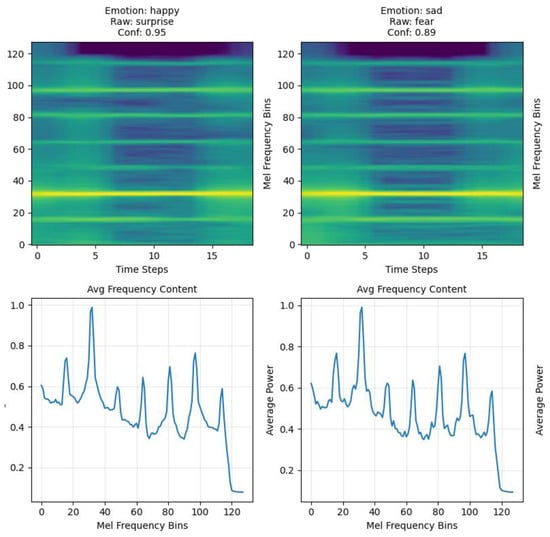
Figure 1
Open AccessArticle
Handheld Lab-on-a-Chip System for Label-Free Dual-Plex Detection of Biomarkers Through On-Chip Plasma Separation
by
Chen-Yuan Chang, Yuan-Pei Lei, Chien Chieh Chiang and Cheng-Sheng Huang
Biosensors 2025, 15(11), 743; https://doi.org/10.3390/bios15110743 - 4 Nov 2025
Abstract
Rapid and reliable detection of biomarkers in complex fluids such as whole blood is essential for effective disease diagnosis and monitoring, particularly in point-of-care settings. Accordingly, this study developed a handheld lab-on-a-chip (LOC) platform that integrates on-chip plasma separation with label-free optical biosensing
[...] Read more.
Rapid and reliable detection of biomarkers in complex fluids such as whole blood is essential for effective disease diagnosis and monitoring, particularly in point-of-care settings. Accordingly, this study developed a handheld lab-on-a-chip (LOC) platform that integrates on-chip plasma separation with label-free optical biosensing for real-time, dual-plex detection of biomarkers. The LOC platform includes a two-stage filtration unit that enables efficient separation of plasma from whole blood. This platform also includes a novel gradient grating period guided-mode resonance sensor array that is capable of simultaneously detecting multiple biomarkers with high sensitivity. A compact handheld reader was developed to acquire and analyze optical signals. By using creatinine and albumin as model biomarkers, we demonstrated that the developed platform could achieve sensitive, specific, and reproducible biomarker detection in both plasma and whole-blood samples. The platform can detect albumin and creatinine at concentrations as low as 0.8 and 1.44 μg/mL, respectively, and it exhibits minimal nonspecific binding. These results highlight the potential of the proposed system as a robust and accessible tool for decentralized diagnostics.
Full article
(This article belongs to the Special Issue Development and Application of Integrated Optical Devices in Biosensing)
►▼
Show Figures
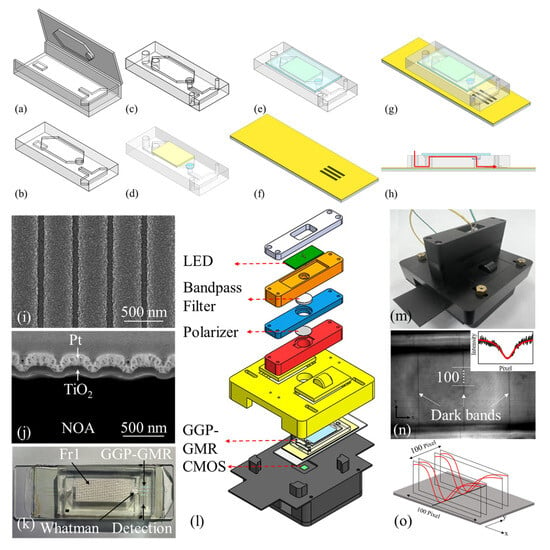
Figure 1
Open AccessArticle
Analysis of Olfactive Prints from Artificial Lung Cancer Volatolome with Nanocomposite-Based vQRS Arrays for Healthcare
by
Abhishek Sachan, Mickaël Castro and Jean-François Feller
Biosensors 2025, 15(11), 742; https://doi.org/10.3390/bios15110742 - 4 Nov 2025
Abstract
Exhaled breath analysis is emerging as one of the most promising non-invasive strategies for the early detection of life-threatening diseases, especially lung cancer, where rapid and reliable diagnosis remains a major clinical challenge. In this study, we designed and optimized an electronic nose
[...] Read more.
Exhaled breath analysis is emerging as one of the most promising non-invasive strategies for the early detection of life-threatening diseases, especially lung cancer, where rapid and reliable diagnosis remains a major clinical challenge. In this study, we designed and optimized an electronic nose (e-nose) platform composed of quantum resistive vapor sensors (vQRSs) engineered by polymer-carbon nanotube nanocomposites via spray layer-by-layer assembly. Each sensor was tailored through specific polymer functionalization to tune selectivity and enhance sensitivity toward volatile organic compounds (VOCs) of medical relevance. The sensor array, combined with linear discriminant analysis (LDA), demonstrated the ability to accurately discriminate between cancer-related biomarkers in synthetic blends, even when present at trace concentrations within complex volatile backgrounds. Beyond artificial mixtures, the system successfully distinguished real exhaled breath samples collected under challenging conditions, including before and after smoking and alcohol consumption. These results not only validate the robustness and reproducibility of the vQRS-based array but also highlight its potential as a versatile diagnostic tool. Overall, this work underscores the relevance of nanocomposite chemo-resistive arrays for breathomics and paves the way for their integration into future portable e-nose devices dedicated to telemedicine, continuous monitoring, and early-stage disease diagnosis.
Full article
(This article belongs to the Special Issue Electrochemical (Bio-)Sensors in Biological Applications—3rd Edition)
►▼
Show Figures

Figure 1
Open AccessArticle
Microfluidic-Integrated, Ring-Resonator-Assisted Mach–Zehnder Interferometer (μFRA-MZI) as a Label-Free Nanophotonic Sensor
by
Yunju Chang, Ethan Glenn Seutter, Zihao Wang and Jiandi Wan
Biosensors 2025, 15(11), 741; https://doi.org/10.3390/bios15110741 - 4 Nov 2025
Abstract
The ring-assisted Mach–Zehnder interferometer (RA-MZI) has high sensitivity and fast optical response time, and it has been used as a label-free nanophotonic biosensor. Most RA-MZI-based biosensors, however, require chemical modification of the ring surface to immobilize biomolecules that can interact with target molecules
[...] Read more.
The ring-assisted Mach–Zehnder interferometer (RA-MZI) has high sensitivity and fast optical response time, and it has been used as a label-free nanophotonic biosensor. Most RA-MZI-based biosensors, however, require chemical modification of the ring surface to immobilize biomolecules that can interact with target molecules for sensing. Here, we report a novel microfluidic-integrated RA-MZI (μFRA-MZI) where a microfluidic channel was fabricated right above the photonic ring resonator. μFRA-MZI allows for direct sample delivery to the RA-MZI without chemical modification of the ring surface and measures shifts in the resonance wavelength induced by the presence of target molecules, enabling label-free detection. In order to optimize the sensitivity of μFRA-MZI, seven devices were fabricated with varied design parameters, including the gap distance between the ring and the bus waveguide (Gring), the length of the multi-mode interferometer (LMMI), and the length of the directional coupler (LDC). Photonic characterization showed that the device with Gring = 1.2 μm, LMMI = 15.5 μm, and LDC = 13.5 μm exhibited the highest extinction ratio (ER) compared to the other six devices, consistent with the simulation-optimized design. Testing with NaCl solutions of varying concentrations yielded a bulk sensitivity of 11.48 nm/refractive index unit (RIU) and an ER of 0.41. With the potential to further improve the device’s sensitivity and the ability to detect samples directly in flow without chemical modifications of the ring resonator, μFRA-MZI will provide a robust and effective approach for label-free biosensing.
Full article
(This article belongs to the Special Issue Design and Application of Microfluidic Biosensors in Biomedicine)
►▼
Show Figures
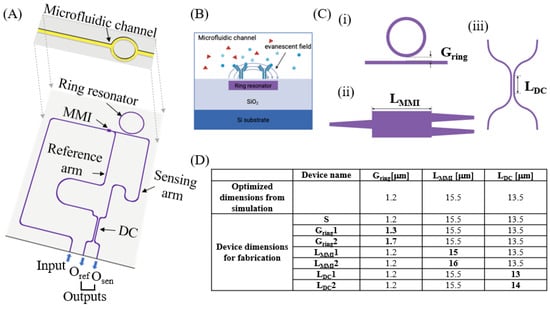
Figure 1
Open AccessArticle
Machine Learning-Assisted SERS Platform for Rapid and Quantitative Discrimination of Shiga Toxin-Producing E. coli Serotypes
by
Yuting Liu, Jiyu Feng, Xinyi Chen, Mingyu Cheng, Jinglan Zhang, Xu Ye, Yiping Zhao and Bin Ai
Biosensors 2025, 15(11), 740; https://doi.org/10.3390/bios15110740 - 4 Nov 2025
Abstract
Rapid, sensitive, and specific detection of pathogenic Escherichia coli serotypes is crucial for food safety and public health. Here, we present a surface-enhanced Raman scattering (SERS) platform utilizing highly ordered silver nanorod (AgNR) arrays functionalized with vancomycin for efficient and selective bacterial capture.
[...] Read more.
Rapid, sensitive, and specific detection of pathogenic Escherichia coli serotypes is crucial for food safety and public health. Here, we present a surface-enhanced Raman scattering (SERS) platform utilizing highly ordered silver nanorod (AgNR) arrays functionalized with vancomycin for efficient and selective bacterial capture. The system enables multiplexed, high-throughput analysis using a portable Raman spectrometer, achieving direct molecular fingerprinting of seven clinically relevant E. coli serotypes. Systematic optimization of AgNR length and vancomycin coating maximized SERS enhancement and capture efficiency. Advanced data analysis with linear discriminant analysis (LDA) provided robust discrimination among all serotypes and concentrations, achieving up to 100% classification accuracy in single-concentration models and an overall accuracy of 98.41% when all concentrations and serotypes were evaluated jointly. This integrated SERS approach demonstrates significant promise for rapid, on-site bacterial diagnostics and quantitative pathogen monitoring, paving the way for practical applications in food safety and clinical microbiology.
Full article
(This article belongs to the Special Issue Artificial Intelligence (AI) and Machine Learning (ML) in Biosensors: Innovation, Application, and Challenge)
►▼
Show Figures

Figure 1
Open AccessArticle
Electrochemical Tracking of Macrophage Migration Inhibitory Factor: A Leap Toward Precision Colorectal Cancer Diagnosis and Prognosis
by
Eloy Povedano, Antonino-Biagio Carbonaro, Verónica Serafín, María Gamella, Alessandro Giuffrida, Ana Montero-Calle, José Manuel Pingarrón, Rodrigo Barderas and Susana Campuzano
Biosensors 2025, 15(11), 739; https://doi.org/10.3390/bios15110739 - 4 Nov 2025
Abstract
Colorectal cancer (CRC) remains a significant global health burden, mainly due to late diagnosis and chemotherapy resistance. Macrophage migration inhibitory factor (MIF), a proinflammatory cytokine associated with tumor progression, has emerged as a promising biomarker in CRC. However, its clinical utility is limited
[...] Read more.
Colorectal cancer (CRC) remains a significant global health burden, mainly due to late diagnosis and chemotherapy resistance. Macrophage migration inhibitory factor (MIF), a proinflammatory cytokine associated with tumor progression, has emerged as a promising biomarker in CRC. However, its clinical utility is limited by the lack of rapid and accessible detection methods. In this study, we report an electrochemical immunotechnology for the sensitive and selective quantification of MIF protein in CRC tissue samples. By combining magnetic microparticles (MMPs), antibody-based recognition, horseradish peroxidase (HRP) labeling, and amperometric transduction at disposable screen-printed carbon electrodes (SPCEs), the developed methodology displayed a linear dynamic range from 0.24 to 20 ng mL−1, enabling quantification across clinically relevant MIF levels, and achieving a low limit of detection (0.07 ng mL−1). In addition, the developed method is the only one reported for MIF assembled on MMPs and addresses its determination in a relevant oncological scenario (paired non-tumoral (NT) and tumoral (T) tissues from individuals diagnosed with CRC at different stages of the disease). The analysis, requiring only 100 ng of tissue extract, allowed efficient discrimination between NT and T paired tissues, and successfully differentiated between healthy, early (I–II) and advanced (III–IV) CRC stages, achieving these results in just 105 min.
Full article
(This article belongs to the Special Issue In Honor of Prof. Evgeny Katz: Biosensors: Science and Technology)
►▼
Show Figures

Graphical abstract
Open AccessArticle
Evaluating the Performance of Hyperspectral Imaging Endoscopes: Mitigating Parameters Affecting Spectral Accuracy
by
Siavash Mazdeyasna, Mohammed Shahriar Arefin, Andrew Fales, Silas J. Leavesley, T. Joshua Pfefer and Quanzeng Wang
Biosensors 2025, 15(11), 738; https://doi.org/10.3390/bios15110738 - 4 Nov 2025
Abstract
Hyperspectral imaging (HSI) is increasingly used in studies for medical applications as it provides both structural and functional information of biological tissue, enhancing diagnostic accuracy and clinical decision-making. Recently, HSI cameras (HSICs) have been integrated with medical endoscopes (HSIEs), capturing hypercube data beyond
[...] Read more.
Hyperspectral imaging (HSI) is increasingly used in studies for medical applications as it provides both structural and functional information of biological tissue, enhancing diagnostic accuracy and clinical decision-making. Recently, HSI cameras (HSICs) have been integrated with medical endoscopes (HSIEs), capturing hypercube data beyond conventional white light imaging endoscopes. However, there are currently no cleared or approved HSIEs by the U.S. Food and Drug Administration (FDA). HSI accuracy depends on technologies and experimental parameters, which must be assessed for reliability. Importantly, the reflectance spectrum of a target can vary across different cameras and under different environmental or operational conditions. Thus, before reliable clinical translation can be achieved, a fundamental question must be addressed: can the same target yield consistent spectral measurements across different HSI systems and under varying acquisition conditions? This study investigates the impact of eight parameters—ambient light, exposure time, camera warm-up time, spatial and temporal averaging, camera focus, working distance, illumination angle, and target angle—on spectral measurements using two HSI techniques: interferometer-based spectral scanning and snapshot. Controlled experiments were conducted to evaluate how each parameter affects spectral accuracy and whether normalization can mitigate these effects. Our findings reveal that several parameters significantly influence spectral measurements, with some having a more pronounced impact. While normalization reduced variations for most parameters, it was less effective at mitigating errors caused by ambient light and camera warm-up time. Additionally, normalization did not eliminate spectral noise resulting from low exposure time, small region of interest, or a spectrally non-uniform light source. From these results, we propose practical considerations for optimizing HSI system performance. Implementing these measures can minimize variations in reflectance spectra of identical targets captured by different cameras and under diverse conditions, thereby supporting the reliable translation of HSI techniques to clinical applications.
Full article
(This article belongs to the Special Issue Advanced Optical Imaging Biosensors: Technologies and Biomedical Applications)
►▼
Show Figures

Figure 1
Open AccessReview
Cancer and Aging Biomarkers: Classification, Early Detection Technologies and Emerging Research Trends
by
Mi-Ran Ki, Dong Hyun Kim, Mohamed A. A. Abdelhamid and Seung Pil Pack
Biosensors 2025, 15(11), 737; https://doi.org/10.3390/bios15110737 - 4 Nov 2025
Abstract
Cancer and aging are two distinct biological processes with shared cellular pathways, such as cellular senescence, DNA damage repair, and metabolic reprogramming. However, the outcomes of these processes differ in terms of proliferation. Understanding biomarkers related to aging and cancer opens a pathway
[...] Read more.
Cancer and aging are two distinct biological processes with shared cellular pathways, such as cellular senescence, DNA damage repair, and metabolic reprogramming. However, the outcomes of these processes differ in terms of proliferation. Understanding biomarkers related to aging and cancer opens a pathway for therapeutic interventions and more effective prevention, detection, and treatment strategies. Biomarkers, ranging from molecular to phenotypic indicators, play an important role in early detection, risk assessment, and prognosis in this endeavor. This review comprehensively examines key biomarkers associated with cancer and aging, highlighting their importance in early diagnostic strategies. The review discusses recent advances in biomarker-based diagnostic technologies, such as liquid biopsy, multi-omics integration, and artificial intelligence, and emphasizes their novel potential for early detection, accurate risk assessment, and personalized therapeutic interventions in cancer and aging science. We also explore the current state of biosensor development and clinical application cases. Finally, we discuss the limitations of current early diagnostic methods and propose future research directions to enhance biomarker-based diagnostic technologies.
Full article
(This article belongs to the Special Issue Applications of Cutting-Edge Biosensors in Environment, Food and Healthcare Field)
►▼
Show Figures

Figure 1
Open AccessArticle
Aggregation-Induced Emission-Based Lateral Flow Immunoassay for Ultra-Sensitive and On-Site Detection of Porcine Epidemic Diarrhea Virus
by
Bin Wang, Xufei Feng, Qian He, Hongwei Shi, Wei Hou, Jianjun Geng and Haidong Wang
Biosensors 2025, 15(11), 736; https://doi.org/10.3390/bios15110736 - 3 Nov 2025
Abstract
The porcine epidemic diarrhea virus (PEDV) has inflicted substantial economic losses on the swine industry, underscoring the need for sensitive point-of-care diagnostics. While lateral flow immunoassays (LFIA) offer rapidity and ease of use, traditional labels like colloidal gold suffer from limited sensitivity. Herein,
[...] Read more.
The porcine epidemic diarrhea virus (PEDV) has inflicted substantial economic losses on the swine industry, underscoring the need for sensitive point-of-care diagnostics. While lateral flow immunoassays (LFIA) offer rapidity and ease of use, traditional labels like colloidal gold suffer from limited sensitivity. Herein, we developed an aggregation-induced emission (AIE)-based LFIA, termed PED-ALFIA, for the highly sensitive detection of the PEDV antigen. PED-ALFIA exhibited a detection limit of 2.44 × 102 TCID50/mL, which represents a 256-fold improvement in sensitivity over commercial colloidal gold kits and a 4-fold enhancement compared to our previously developed PED-TRFIA. The assay showed no cross-reactivity with other common swine viruses and demonstrated high reproducibility. When tested on clinical samples (n = 42), results showed 100% concordance with qPCR. Utilizing a portable fluorescence reader, the assay can be completed within 10 min, establishing PED-ALFIA as a sensitive, specific, and rapid on-site tool for the early diagnosis of PEDV.
Full article
(This article belongs to the Section Biosensors and Healthcare)
►▼
Show Figures
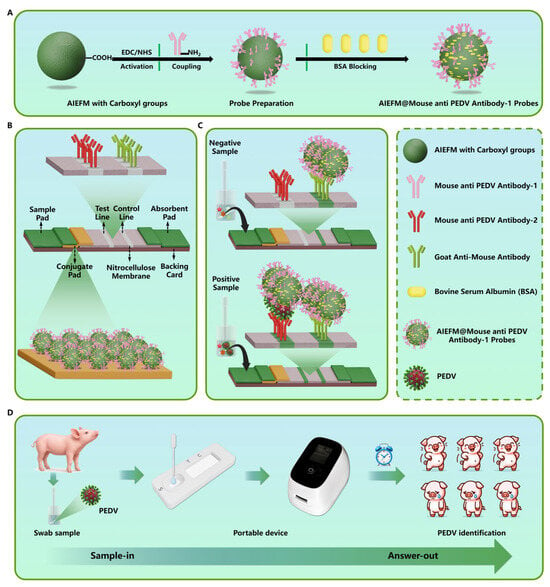
Figure 1
Open AccessArticle
Novel Nanocomposites of Carbon Nanomaterials and Poly(Neutral Red) Electropolymerized from Reline for DNA Damage Detection and Beverage Antioxidant Influence Assessment
by
Anastasia Malanina, Rufiia Derbisheva, Tatiana Krasnova, Rezeda Shamagsumova, Vladimir Evtugyn, Alexey Ivanov and Anna Porfireva
Biosensors 2025, 15(11), 735; https://doi.org/10.3390/bios15110735 - 3 Nov 2025
Abstract
Novel nanocomposites based on carbon black or multi-walled carbon nanotubes functionalized with carboxylic groups and Neutral red electropolymerized from reline were obtained in a one-step protocol and used for DNA biosensor development. The synthesis was carried out in potentiodynamic mode in a deep
[...] Read more.
Novel nanocomposites based on carbon black or multi-walled carbon nanotubes functionalized with carboxylic groups and Neutral red electropolymerized from reline were obtained in a one-step protocol and used for DNA biosensor development. The synthesis was carried out in potentiodynamic mode in a deep eutectic solvent reline consisting of a mixture of choline chloride and urea. The nanocomposite based on carbon black and poly(Neutral red) was applied for a voltammetric DNA biosensor developed to discriminate DNA damage. The sensor developed allowed the native, thermally denatured, and chemically oxidized DNA discrimination with either current changes or peak potential shifts. The nature of the DNA used had affected the sensor’s analytical response value. The DNA biosensor suggested was tested for the assessment of antioxidant capacity in such beverages as tea, coffee, white wine, and fruit-based drink purchased from local market. Simple, fast, and inexpensive approach of sensor modifying layer assembly would be demanded in control of food products and beverages quality, as well as for medical purposes.
Full article
(This article belongs to the Special Issue Nanotechnology Biosensing in Bioanalysis and Beyond)
►▼
Show Figures

Figure 1

Journal Menu
► ▼ Journal Menu-
- Biosensors Home
- Aims & Scope
- Editorial Board
- Reviewer Board
- Topical Advisory Panel
- Instructions for Authors
- Special Issues
- Topics
- Sections & Collections
- Article Processing Charge
- Indexing & Archiving
- Editor’s Choice Articles
- Most Cited & Viewed
- Journal Statistics
- Journal History
- Journal Awards
- Conferences
- Editorial Office
Journal Browser
► ▼ Journal BrowserHighly Accessed Articles
Latest Books
E-Mail Alert
News
Topics
Topic in
Applied Sciences, Biosensors, Designs, Electronics, Materials, Micromachines, Applied Biosciences
Wearable Bioelectronics: The Next Generation of Health Insights
Topic Editors: Shuo Gao, Yu Wu, Wenyu WangDeadline: 31 March 2026
Topic in
Applied Nano, Biosensors, Materials, Nanomaterials, Chemosensors, Applied Biosciences, Laboratories
Applications of Nanomaterials in Biosensing: Current Trends and Future Prospects
Topic Editors: Kundan Sivashanmugan, Xianming KongDeadline: 30 April 2026
Topic in
Analytica, Biosensors, Foods, Molecules, Pharmaceuticals, Separations, Environments, Chemosensors
Innovative Analytical Approaches for Natural Products and Pharmaceuticals in Complex Matrices
Topic Editors: Rosanna Ciriello, Filomena Lelario, Carmen TesoroDeadline: 30 June 2027
Topic in
Biosensors, IJMS, Applied Nano, Biophysica, Nanomaterials
Nanomaterials or Bioreceptors Involved in Biosensing Technologies
Topic Editors: Robert Ziółkowski, Seyed R. TabaeiDeadline: 31 August 2027

Conferences
Special Issues
Special Issue in
Biosensors
Aptamer-Based Biosensors for Point-of-Care Diagnostics
Guest Editors: Ana Díaz-Fernández, Cecilia CristeaDeadline: 15 November 2025
Special Issue in
Biosensors
Advanced Microfluidic Devices and Lab-on-Chip (Bio)sensors
Guest Editors: Pablo Giménez-Gómez, Roberto PillotonDeadline: 20 November 2025
Special Issue in
Biosensors
Novel Designs and Applications for Electrochemical Biosensors
Guest Editors: Defang Liu, Kevin C. HoneychurchDeadline: 25 November 2025
Special Issue in
Biosensors
Micro/Nanofluidic System-Based Biosensors
Guest Editors: Mengren Wu, Yuan Gao, Yang LinDeadline: 25 November 2025
Topical Collections
Topical Collection in
Biosensors
Microsystems for Cell Cultures
Collection Editors: Iordania Constantinou, Thomas E. Winkler














